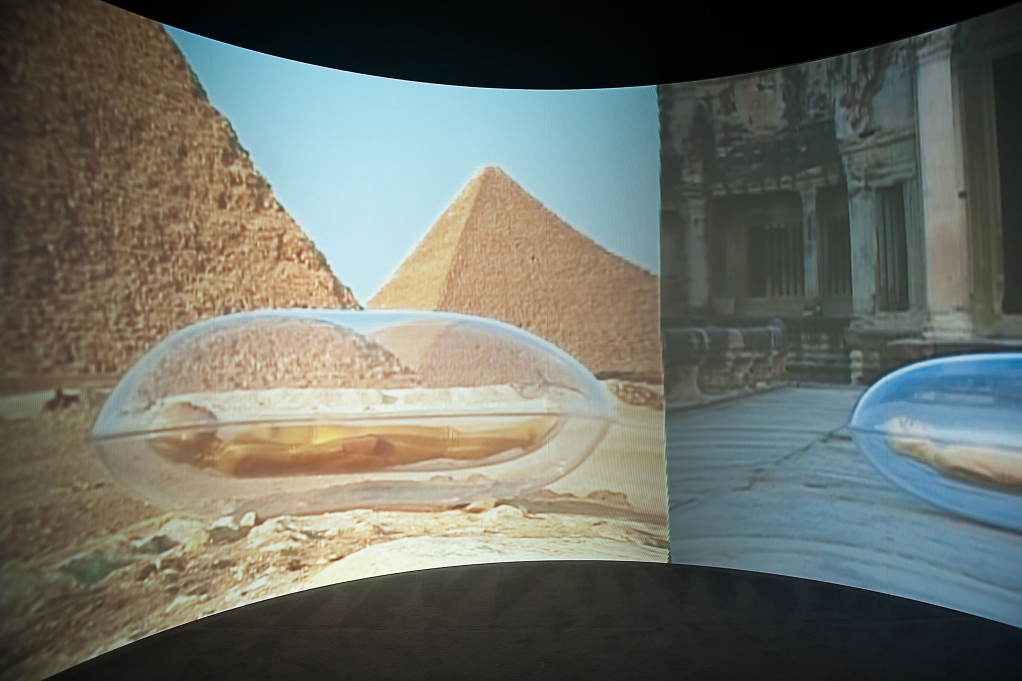Installations II: Video from the Guggenheim Collections
03.03.2009 - 01.17.2010
Following the 2008 exhibition Installations: Selections from the Guggenheim Collections, this presentation investigates the ways in which contemporary artists have used video to create sites of immersion and discovery. From its first uses in the late 1960s, video has played an important role in artists' examinations of self and society, providing a unique means of harnessing real time and space that has become increasingly sophisticated as technologies have advanced over the decades.
Today artists employ video in lush and complex installations that transport viewers to universes beyond the bounds of the museum, in the process subtly reorienting the audience to its everyday environment. Frequently these works adopt the conventions of cinema, employing narrative structures or theater-scale projections and sound; at the same time artists have pushed beyond the boundaries of these conventions, for example by using multiple screens within a single space. Many artists have also extended the sense of visual exploration that multi-channel video enables by adding sculptural props or specially designed furniture to their installations, creating a unique environment for viewers.
The seven works in this exhibition have all been acquired by the Guggenheim during the past five years, attesting to the museum's ongoing commitment to this vital field of contemporary art. These installations offer a glimpse of the diverse range of themes and styles that occupy artists working with video today. In Zidane, a 21st century portrait (2006), Douglas Gordon and Philippe Parreno create a cinematic portrayal of soccer player Zinédine Zidane in real time over the course of a single match. Shown on two contiguous screens and accompanied by a stirring soundtrack, Zidane exposes the labor that lies behind the heroic mythos of the sports star. Slater Bradley's The Doppelganger Trilogy (2001-04) also focuses on icons of popular culture, conjuring the ghostly presence of musicians Kurt Cobain, Ian Curtis, and Michael Jackson through the distancing lens of desire and memory. By recreating the performances of these fallen heroes-victims of suicide or, in Jackson's case, an inexorable decline into disrepute-Bradley reflects on the lure of celebrity, the erotics of fan worship, and the seduction of abandonment, dipping into the collective unconscious of our mass media-oriented culture.
Ryan Trecartin's feature-length video I-Be Area (2007) offers an entirely different take on the role of media icons in contemporary culture, looking to the internet, where new identities and communities can be constructed virtually, propelling even the most common of us into a self-made spotlight. Using a distinctive do-it-yourself aesthetic and rapidly edited, jargon-filled dialogue, Trecartin catapults viewers into an alternate reality in which cybernetic avatars run amok, gleefully playing out a complex web of melo-dramatic fictions. Mika Rottenberg, too, invents a sort of virtual reality in Dough (2006), creating an absurdist assembly line in which a cast of characters─including a woman grotesquely overweight and another who is eerily thin-mold and package raw dough. The enclosed spaces in which these actors appear are echoed by the structure that Rottenberg builds around her video in the gallery, immersing audiences in the claustrophobic setting of the piece. The function of fantasy that is implicitly referenced in Trecartin's and Rottenberg's works is brought to the fore in Cao Fei's video Whose Utopia (2006). This semi-documentary plumbs the realities of daily life at a massive Chinese light bulb factory, portraying the grinding monotony of its machinelike labor while also giving voice to the fantasies of its workers, who dance and play music amidst the factory spaces as if in a dream.
Isaac Julien's Paradise Omeros (2002) extends this dreamlike ambiance, employing a richly imagined, elliptical narrative to explore the social, political, and emotional terrain of postcolonialism. Oscillating between the Caribbean island of St. Lucia and gritty downtown London, Julien's three-channel video poetically addresses the phenomenon of the Creole─that hybrid state in which a single subject embodies the histories and identities of multiple cultures and places. Finally, in Link (1995–2000), Mariko Mori transports the audience to a space of contemplation through a 360-degree, four-channel video projection that documents a series of performances in major cities and archeological sites around the world. In each location, the artist lies dormant in her signature "body capsule." These acts, when witnessed together in the installation, unify the various sites across boundaries of time and place, aiming to create a transcendent, utopian space.
Mariko Mori
Link, 1995–2000
Four-channel color video installation, with sound, 9 minutes, 15 seconds
Edition 2/2
Solomon R. Guggenheim Museum, New York

